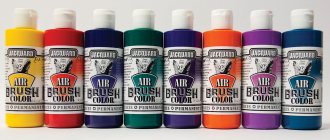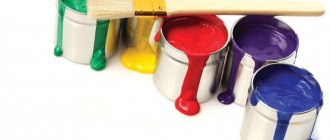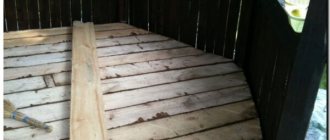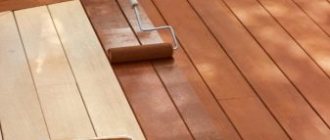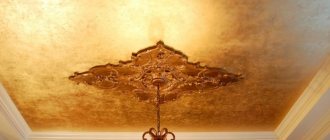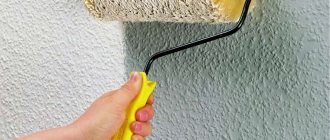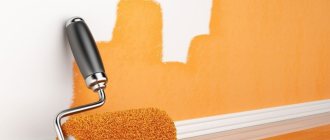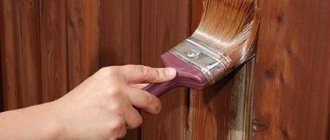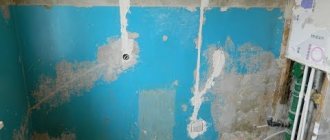Michel
12604 0 34
Michel November 12, 2016Specialization: plumber with 10 years of experience, computer repair specialist, powerlifting coach. I have extensive experience in construction, interior decoration, and making homemade furniture. Hobbies: sports
This article is about how to paint drywall and how to do it correctly. In it I will talk about what paints can be used on gypsum boards in rooms for various purposes. The preparation of the drywall surface for painting and the application of the finishing coating deserve special mention. So, let's go.
Paints on a store window. Our task is to make the right choice.
Requirements for the structure to be painted
Preparation for painting begins at the stage of assembling the frame and covering it with plasterboard sheets. The structure should be monolithic, seamless and stable, since the slightest shifts of the sheets will lead to cracks and peeling, and the drywall paint will begin to crumble.
Therefore, the frame elements are rigidly connected to each other, and the cladding is screwed onto it with special self-tapping screws, ensuring reliable fixation. In new wooden houses subject to shrinkage, a so-called floating frame is installed, and gaps are left between the sheathing sheets and the plane of the floor and ceiling. In addition, the design must have perfectly correct planes and angles, otherwise the paint will highlight all the defects and differences at the joints.
Experienced finishers always take such nuances into account, so it is better to trust only them with the construction of plasterboard partitions, cladding of ceilings and walls. Source prorab.help
Certain requirements are also imposed on the surface itself. The surface of plasterboard is a multilayer paper that gets wet, swells upon contact with a damp substance, and unevenly absorbs paint. If a plasterboard ceiling is painted directly over it, the surface will not have an aesthetic appearance.
Clearly visible seams between the sheets, even if the installation is done very carefully, and the heads of metal screws showing through the paint, from which the coating will peel off very quickly, will not add beauty to it.
There is only one way to avoid this - by covering the surface with a thin layer of putty. It performs several functions at once:
- protects the paper layer from moisture and reduces its absorbency;
- hides joints and fastenings;
- evens out the color of the surface.
An attempt to save money and putty only the seams, recesses from self-tapping screws and surface defects before painting the drywall often leads to uneven painting, especially when using light-colored water-based compounds.
Such a surface cannot be painted; it must be completely puttied. Source mirbetona.info
Proper sealing of joints of gypsum board sheets is the key to high-quality painting
Joints of gypsum board sheets are a problem that many people encounter when painting. Nothing seems to be a sign of trouble, but literally after half a year, or even less, cracks will form on the already painted wall. These cracks form at the joints of sheets.
Let's find out why this happens and how to avoid it. The fact is that many craftsmen seal the joints of gypsum board sheets with a “serpyanka” mesh, which does not sufficiently reinforce the seam and the seams crack. To seal gypsum board seams, it is better to use paper tape, or even better, combine both serpyanka and tape, and also putty the entire drywall in two layers! But this is already a bit expensive, so we are considering an option without putty.
To seal gypsum board joints for painting, instead of “serpyanka”, it is better to use a special paper tape for gypsum board joints.
Tape for joints of drywall sheets
You can also stick sickle tape onto the joints under the wallpaper; you still can’t see under the wallpaper that cracks have appeared, and this won’t cause the wallpaper to tear, but you need to use tape when painting drywall.
I recommend: Drywall for finishing a loggia or balcony
It is better to seal the joints with a special putty, especially for gypsum board joints, it is stronger and more reliable. Self-tapping screws screwed into the gypsum board must be recessed into the sheet and these places must also be puttied.
The joints are glued with paper tape and puttied, the holes from the screws are also
Surface preparation algorithm
Since the answer to the question of whether it is possible to paint drywall without preparation is definitely negative, you need to figure out how to properly carry out this preparation. The whole process can be divided into several stages.
- Inspect the surface for cracks, protruding joints, poorly screwed screws protruding beyond the surface.
- Treatment with acrylic primer for better adhesion to putty.
To prevent the paper from absorbing moisture from the solution, the surface is primed Source obustroeno.com
- Reinforce joints with masking tape and reinforce corners.
- Puttying joints, corners, fastening holes and surface defects.
- Rubbing the putty after drying.
- Applying a continuous thin layer of putty.
- Sanding the surface after the putty has dried.
- Re-priming with 2 layers of penetrating primer.
For leveling, use gypsum or polymer finishing putty. Source gipsmontaj-st.ru
A detailed description of all these processes is in other materials on the site; if necessary, you can familiarize yourself with them.
See also: Catalog of companies that specialize in paints and varnishes and related work
Painting plasterboard walls is the optimal solution
Although you don’t need specific skills to work with paints, you should take into account the application features of each type of material.
It is also necessary to know the correct application technique so that the result is better than expected.
Water-based paint is most often used for smooth and embossed surfaces; it is easy to apply and hides flaws on the walls and ceiling, if any.
The water emulsion guarantees the durability and freshness of the repair for 5 years, the colors themselves do not fade or fade.
Choosing paint and tools
When everything is ready for the final finishing, it’s time to decide how to paint the drywall - what paint to choose and what tool is best to apply it.
Types of paints suitable for gypsum boards
Before choosing a coloring composition, determine the color and the requirements for it. This may be the coating’s resistance to wet cleaning, degree of abrasion, drying speed, lack of odor, environmental friendliness, etc.
Since the paint is applied not to the drywall itself, but to the putty, a variety of compositions are suitable for painting it. But most often, water-based paints are chosen for interior work in residential buildings, and alkyd enamels are used for finishing surfaces in rooms with high humidity and the need for frequent cleaning.
Walls and ceiling painted with acrylic water-based emulsion Source melbournepainting.services
Painting drywall with water-based paint allows you to choose any desired shade and surface texture. Even if the desired color is not among the ready-made compositions, it is obtained by mixing a white base with a tinting pigment. Whether the wall will be perfectly smooth or slightly rough depends on the choice of tool.
The basis of any water-based emulsion is water, and the paint is diluted with it to obtain the desired consistency. The properties of paint depend on what components are included in its composition.
- Acrylics are the most popular and inexpensive. Most of them are not very resistant to moisture, so they can only be used for decorating dry rooms. But there are also moisture-resistant compounds that can withstand wet cleaning.
- Latex ones are more resistant to both moisture and abrasion, do not absorb dirt, are easy to apply and last a long time.
Latex paint for ceilings Source stroylandiya.ru
- Silicone coatings are the most expensive, but at the same time the most convenient to use coatings, especially for rooms where temperature changes, increased air humidity, and the appearance of mold are possible. They can be cleaned, washed, and disinfected without harm to their appearance.
- Silicate paints are similar in properties to silicone paints, but the liquid glass they contain makes the surface impenetrable not only to water, but also to air.
What types of finishes are used for drywall
After creating the plasterboard structure, you can begin treating the surface with finishing materials.
It is important that during installation of the sheets all fire safety standards are observed. When finishing drywall, the following options are used:
- wallpapering;
- painting with waterproof and structural paint;
- finishing with mosaics and ceramic tiles;
- textured plaster;
- cork covering;
- flat stone finishing.
The top of the decorative plaster and painting can be coated with glossy or matte varnish.
As you can see, there are many finishing options, and all of them are acceptable for drywall, now it all depends on the design and preference of the owner. Before using these materials, you need to stock up on the necessary tools and knowledge.
Dyeing technology
Before painting drywall, you should prepare the paint by mixing it thoroughly and, if necessary, diluting it with water or a recommended solvent. The volume of liquid for dilution should not be more than indicated in the instructions.
If you decide to tint the paint, then it is better to do it in a store where there are special machines. It is impossible to achieve the same shade in each jar on your own; you will have to pour them into one large container and tint the entire volume.
Advice! Before painting plasterboard walls, it is recommended to do test paints and let them dry to evaluate the actual color of the future coating. If necessary, you can adjust the shade by adding a little color or a white base.
After drying, the paint may slightly change shade Source forum.ivd.ru
To work, you will need a paint bath, a spatula for mixing paint and masking tape. To avoid staining floors or furniture, they are covered with film.
- A portion of paint is poured into the bath.
- First, paint with a brush all those areas where it is impossible to reach with a roller or where it can stain the adjacent surface - internal corners, the area along the baseboards and cornices, niches, etc.
- The main area is treated with a roller, which is dipped in paint and rolled along the ribbed surface of the tray to remove excess paint.
- Drywall paint for walls is applied from top to bottom, the ceiling is painted in parallel stripes from one to the opposite wall.
- After treating a small area, immediately roll it over again without dipping it into paint - this technique allows you to remove drips.
If individual areas need to be painted a different color, they are covered along the border with masking tape Source interieurdesigner.be
The minimum number of layers of paint is two. The second and subsequent ones are applied to the dried surface in a direction transverse to the previous one. The quality of painting is checked using a bright lamp directed at an angle to the surface. If necessary, the defective area can be sanded and repainted.
